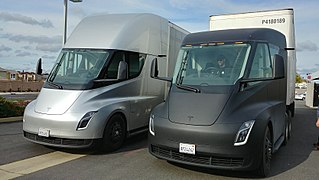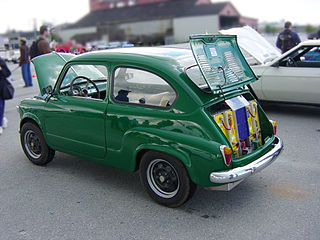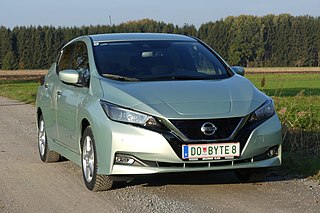Related Research Articles

A hybrid vehicle uses two or more distinct types of power, such as internal combustion engine to drive an electric generator that powers an electric motor, e.g. in diesel-electric trains using diesel engines to drive an electric generator that powers an electric motor, and submarines that use diesels when surfaced and batteries when submerged. Other means to store energy include pressurized fluid in hydraulic hybrids.

An electric vehicle, also called an EV, uses one or more electric motors or traction motors for propulsion. An electric vehicle may be powered through a collector system by electricity from off-vehicle sources, or may be self-contained with a battery, solar panels or an electric generator to convert fuel to electricity. EVs include, but are not limited to, road and rail vehicles, surface and underwater vessels, electric aircraft and electric spacecraft.

A diesel–electric transmission, or diesel–electric powertrain, is used by a number of vehicle and ship types for providing locomotion.

A zero-emissions vehicle, or ZEV, is a vehicle that emits no exhaust gas from the onboard source of power. Harmful pollutants to the health and the environment include particulates (soot), hydrocarbons, carbon monoxide, ozone, lead, and various oxides of nitrogen. Although not considered emission pollutants by the original California Air Resources Board (CARB) or U.S. Environmental Protection Agency (EPA) definitions, the most recent common use of the term also includes volatile organic compounds, several air toxics, and global pollutants such as carbon dioxide and other greenhouse gases.
Global Electric Motorcars (GEM) is an American manufacturer in the low-speed vehicle category, producing neighborhood electric vehicles (NEVs) since 1998, low-speed vehicles (LSVs) since 2001. It has sold more than 50,000 GEM battery-electric vehicles worldwide as of October 2015. GEM was formerly owned by Chrysler. Since 2011 it is a wholly owned subsidiary of Polaris Industries.

A plug-in hybrid electric vehicle (PHEV) is a hybrid electric vehicle whose battery can be recharged by plugging it into an external source of electric power, as well as by its on-board engine and generator. Most PHEVs are passenger cars, but there are also PHEV versions of commercial vehicles and vans, utility trucks, buses, trains, motorcycles, scooters, and military vehicles.

In automobile engineering, electric vehicle conversion is the replacement of a car's combustion engine and connected components with an electric motor and batteries, to create an all-electric vehicle. Another option is to replace a large combustion engine with an electric motor and a small combustion engine, creating a hybrid electric vehicle or a plug-in hybrid electric vehicle.

The Edison Storage Battery Company was organized in New Jersey on May 27, 1901, to develop, manufacture, and sell the Thomas A Edison, Inc Edison Storage Battery Division label.
Hybrid vehicle drive trains transmit power to the driving wheels for hybrid vehicles. A hybrid vehicle has multiple forms of motive power.

Modec was an electric vehicle manufacturer in Coventry, in the United Kingdom, specialising in Commercial vehicles in the N2 category. It unveiled its first model in April 2006 and announced its intention to commence series production in March 2007, with the first production vehicles destined for Tesco. Following a long-term decline in sales, it entered administration in March 2011, with all remaining assets and intellectual property sold to Navistar International.
All-electric range (AER) is the driving range of a vehicle using only power from its electric battery pack to traverse a given driving cycle. In the case of a battery electric vehicle, it means the total range per charge. For a plug-in hybrid (PHEV), it means the range of the vehicle in charge-depleting mode. PHEVs can travel considerably further in charge-sustaining mode which uses both on-board fuel and the battery pack.

An electric vehicle charging station, also called EV charging station, electric recharging point, charging point, charge point, electronic charging station (ECS), and electric vehicle supply equipment (EVSE), is an element in an infrastructure that supplies electric energy for the recharging of plug-in electric vehicles—including electric cars, neighborhood electric vehicles and plug-in hybrids.

Valence Technology, Inc. develops and manufactures lithium iron phosphate cathode material as well as lithium ion battery modules and packs. The modules come in 12 V, 18 V, 24 V, and 36 V configurations. Valence's products are used in electric vehicle and plug-in hybrid electric vehicles (PHEVs) such as cars, scooters, motorbikes, and commercial vehicles such as buses, delivery vans and trucks. Valence batteries are also used in wheelchairs, medical carts, robotics, marine, rail, as well as stationary applications such as remote power, uninterruptible power supply (UPS), energy storage systems, frequency regulation and switching gear.

An electric-vehicle battery (EVB) in addition to the traction battery speciality systems used for industrial vehicles, are batteries used to power the propulsion system of a battery electric vehicle (BEVs). These batteries are usually a secondary (rechargeable) battery, and are typically lithium-ion batteries. Traction batteries, specifically designed with a high ampere-hour capacity, are used in forklifts, electric golf carts, riding floor scrubbers, electric motorcycles, electric cars, trucks, vans, and other electric vehicles.

An electric car is an automobile that is propelled by one or more electric motors, using energy stored in rechargeable batteries. The first practical electric cars were produced in the 1880s. Electric cars were popular in the late 19th century and early 20th century, until advances in internal combustion engines, electric starters in particular, and mass production of cheaper gasoline vehicles led to a decline in the use of electric drive vehicles.

A battery electric vehicle (BEV), pure electric vehicle, only-electric vehicle or all-electric vehicle is a type of electric vehicle (EV) that uses chemical energy stored in rechargeable battery packs. BEVs use electric motors and motor controllers instead of internal combustion engines (ICEs) for propulsion. They derive all power from battery packs and thus have no internal combustion engine, fuel cell, or fuel tank. BEVs include – but are not limited to – motorcycles, bicycles, scooters, skateboards, railcars, watercraft, forklifts, buses, trucks, and cars.

The Electrosport was a compact-sized electric vehicle using AMC Hornets that were converted by the Electric Fuel Propulsion Company (EFP) of Ferndale, Michigan.

A plug-in electric vehicle (PEV) is any vehicle that can be recharged from an external source of electricity, such as wall sockets, and the electricity stored in the rechargeable battery packs drives or contributes to drive the wheels. PEV is a subset of electric vehicles that includes all-electric, or battery electric vehicles (BEVs), and plug-in hybrid vehicles (PHEVs). In China, plug-in electric vehicles are called new energy vehicles (NEVs). Sales of the first mass-production PEV by major carmakers began in late December 2010, with the introduction of the all-electric Nissan Leaf and the plug-in hybrid Chevrolet Volt.

Fisker Inc. is an American electric vehicle automaker founded by Henrik Fisker. Launched in 2016 and based in Southern California, Fisker Inc. is the relaunch of the Fisker brand previously known as Fisker Automotive, which produced the Fisker Karma. Fisker Inc. is developing the Fisker EMotion, an all-electric sedan that will have a 400-mile electric range; an autonomous, all-electric shuttle called the Fisker Orbit; and a mass-market electric vehicle SUV called the Fisker Ocean.
References
- ↑ "The Battery-Electric Transport Future" (PDF). Contact. 24 (9, September 1972): 183–186. 1972.
| This article about an organisation in the United Kingdom is a stub. You can help Wikipedia by expanding it. |